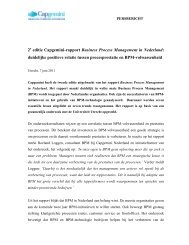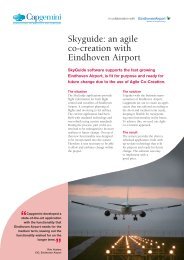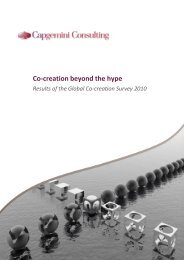IT transformations - Capgemini Consulting Nederland
IT transformations - Capgemini Consulting Nederland
IT transformations - Capgemini Consulting Nederland
Create successful ePaper yourself
Turn your PDF publications into a flip-book with our unique Google optimized e-Paper software.
Figure 2: Actions taken by Telcos on their Business Model<br />
TARGET INTERACTION CREATION<br />
Defining the revenue potential Defining the customer relation Defining profitable means of<br />
achieving target and interaction<br />
Value<br />
Proposition<br />
MARKETS<br />
Acquiring Zain<br />
Africa<br />
CUSTOMER<br />
SEGMENT<br />
OFFERING<br />
MVNOs* for<br />
niches<br />
Tweaking price<br />
plans<br />
Entering utility<br />
sector<br />
Revenue<br />
Model<br />
RELATIONSHIP<br />
Employing<br />
social media<br />
CHANNEL<br />
Use of MVNO<br />
Tuenti<br />
PAYMENT LOGIC<br />
Ad-funded price<br />
plan<br />
Customer<br />
involvement<br />
Note: *MVNO – Mobile Virtual Network Operator **BSS – Business Support Systems<br />
Source: <strong>Capgemini</strong> analysis; Company websites and press releases<br />
Cost Base<br />
CORE ASSETS<br />
Outsourcing<br />
global network<br />
operations<br />
CORE PROCESSES<br />
BSS**<br />
simplification<br />
PARTNER NETWORK<br />
Partnering with<br />
media<br />
Interaction defines the manner in<br />
which the company interacts with the<br />
customer to meet their requirements<br />
with products and services. It also<br />
consists of three elements. The first<br />
element is the customer relationship,<br />
with a focus on the nature of the<br />
relationship, the necessary intensity,<br />
the duration, the content and the<br />
typical and ideal sequence of events<br />
during customer interaction. The<br />
second element is the channels of<br />
distribution through which products<br />
and services should be marketed or<br />
which facilitate the interaction with<br />
customers before and after the sale.<br />
And the third element is the payment<br />
structure with a clear definition of the<br />
mode, point of time, and frequency<br />
of payments. In total, these elements<br />
define the structure of the business’<br />
income flow.<br />
Creation builds on the first two<br />
dimensions of Target and Interaction.<br />
It defines how a company can<br />
profitably fulfil its value proposition.<br />
The essential elements are the<br />
assets and special capabilities that<br />
the company brings into value<br />
creation. These could be production<br />
facilities, the brand of the company,<br />
or technologies. Another element<br />
is the specific processes that the<br />
company has to master for delivering<br />
its services. Finally, it is necessary to<br />
address which service components<br />
have to be delivered in-house –<br />
considering the background of<br />
the desired quality, costs and<br />
flexibility – and which should be<br />
ordered from a network of partners.<br />
The organization of value creation<br />
essentially characterizes the cost basis<br />
of the company and also determines<br />
the competitive capacity and<br />
sustainability of the business model.<br />
Evolution in Telco Business Models<br />
Telcos have made efforts to innovate<br />
across the three major dimensions,<br />
through a combination of market,<br />
channel, and network initiatives<br />
(see Figure 2).<br />
Changes in Target<br />
Telcos have begun to make changes to<br />
their core value proposition. Multiple<br />
telcos have realized the need for<br />
expanding their footprint in order<br />
to tide over maturing home markets.<br />
India’s Bharti Airtel realized that<br />
competition in the Indian mobile<br />
market was growing rapidly, and in<br />
order to diversify, went ahead and<br />
acquired the African operations of<br />
Zain 5 . Similarly, operators have also<br />
entered completely new sectors.<br />
Magyar Telecom has recently entered<br />
the utilities market through a<br />
reselling agreement with E.ON AG<br />
for gas and energy. The operator is<br />
also offering smart metering services<br />
in select cities in Hungary 6 . Multiple<br />
operators have shown readiness to<br />
modify their offerings to address<br />
evolving business and consumer<br />
realities. Most operators started off<br />
mobile broadband pricing plans on<br />
a flat rate model. However, once it<br />
started becoming clear to them that<br />
there was a challenge of monetization,<br />
they are now moving onto tiered<br />
pricing based on downloads. Some<br />
5 Company website.<br />
6 Wireless Federation, Hungary’s Magyar Telekom & E.ON AG Sign Power Retail Sales Deal, May 2010.<br />
78
















